The Pavilion Theatre Abertillery.
On Monday 3rd of June 1907, the Pavilion Theatre, Abertillery, (as seen in the main featured image above) was officially opened and equipped through the enterprise of Mr Arthur Tilney, of Carlyle House, Abertillery. Mr Tilney had been an advocator of the arts and performances in Abertillery and in the 1890’s had organised the many travelling theatres in their visits to his grounds close to his works at Carlyle Street, Bridge Street area close to the Railway Inn. Mr Tilney’s sons Ernest and Harold Tilney were also involved as licensees and later lessees.
Description of the Building.
The Pavilion Theatre was 110′ feet in length 45′ feet wide with a large rising gallery at the back and galleries at the sides, there was also a rising floor, the stage was 35′ feet deep. It was the second largest stage in Wales, second only to Cardiff’s New Theatre. The seating accommodation was for 1,600 spectators with tip-up chairs. The theatre was fully decorated in a cream and crimson colour.
The building had two exits into Bridge Street and two into Carlyle Street. The emergency exit doors were push-outwards with separate exits from the galleries and stage. There was good ante-room accommodation for actors and artistes etc.
The Pavilion was lighted throughout by electric light, the dynamo was worked by the new patent suction gas plant which had been supplied by Mr Henry Ward Williams of the Foundry, Abertillery and the lighting installation was carried out by Messrs Geo Sutcliffe and Co, Abertillery. The heating installation was on the high-pressure system carried out by Messrs Hampton & Co, Cardiff.
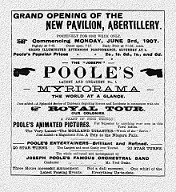 The Opening Show.
The Opening Show.
The first amusement to be shown at the Pavilion Theatre was Mr Joseph Poole’s Myriorama called “The World at a Glance” The Pavilion Theatre undertaking was the long-cherished desire on the part of Mr Tilney, to provide permanent entertainment on strict temperance lines. Mr E. Pryce the manager had in the past been associated with the management of Messrs Poole’s Theatre at Porth and Gloucester and other travelling theatre companies. The Pavilion’s Orchestra was conducted by Mr F. Drake.
The performances were twice nightly from 6.50pm-9.00pm and 9.00pm-11.00pm. Prices costs from 1s. 6d. 6d. and 3d. and weekends and holidays 4d.
After the first performances the Pavilion Theatre closed until August. It’s not known why at this moment. It may have been while the owners were obtaining first class acts.
The Pavilion Advertising Curtain.
In June 1907 it was reported that the Pavilion Theatre had an advertising curtain, this curtain was said to have been the most popular advertising medium in the Western Valleys and to obtain spaces on it to advertise one had to apply to – Mr William Elliott, care of Buckley’s Temperance Hotel, Oak Street, Abertillery.
The Official Opening to the Public.
On Monday 5th of August 1907, the Pavilion opened to the public. The first acts were The Villions, Daisy Morell, The Pavilion Electric Bioscope and The Marvellous Avolos. The resident orchestra were the Pavilion Band under the direction of Mr F. J. Bathurst, R.A.M. The prices of admission were – 1s. 6d., 1s., 6d., and 3d. Saturday’s and holidays were 4d.
Most acts performed from Monday to Friday twice nightly, first performance 6.50pm and the second between 9.00pm and 11.00pm.
Performances at the Pavilion.
As well as having the different variety of live performances the Pavilion Theatre also showed Bioscopic pictures in between acts. A Bioscope was an early film projector.
Staff.
In August 1907 advertisements were placed in the South Wales Gazette for cleaners at the Pavilion Theatre and also a barmaid to work at the temperance bar at the theatre. The barmaids’ hours were 5.00pm to 11.00pm. The advertisement stated the applicant must be a young lady with a smart appearance, honest and quick.
Madame Ella’s Lions.
In August 1907 Madame Ella’s Lions were to appear at the Pavilion Theatre, Abertillery, though the show was cancelled as the previous week, on the 28th of July whilst training for a show at the Palace Theatre of Varieties at Gloucester, the trainer and lion tamer Mr Joseph Hasselmenn the chief assistant to Madam Ella was killed by a lion he had been training, the lion was said to have been a full-grown African Cape lion.
The Pavilion Band.
On Monday 19th of August 1907, the Pavilion Band were under the direction of Mr William Dexter.
Mr George Austin.
In September 1907 Mr George Austin took over as musical director.
Tessus Fernandez and the Spanish Acrobats.
On Sunday 8th of September 1907, the troupe of Spanish acrobats that were booked to perform at the Pavilion Theatre, Abertillery were waiting at the railway station at Newport to catch a train to Abertillery. The acrobats were confronted by two drunken men from Abercarn, reported to be miners from that area out on a day trip. One of the drunkards accosted a female member of the acrobat team, a male member of the troupe called Tessus Fernandez stepped forward to help his female assistant, he threw a punch at one of the men and rendered him unconscious. The drunkard was taken to the Newport County Hospital with a fractured skull and later fined 10s. 6d. for affray. Mr Tessus Fernandez was arrested and remanded in custody.
On Friday 27th of September 1907, Mr Fernandez appeared in court at Newport and was fined £5, equivalent to £591.49p in today’s money. It was stated that his acrobatic troupe had lost £50 in unfulfilled contracts in consequence of Mr Fenandez being remanded in custody for nineteen days. The money lost, totalling £50 is equivalent to £5,914.92p in today’s money.
Special Railway Service.
In November 1907 it was announced in the South Wales Gazette via the Pavilion advertisements that the Great Western Railway Company would begin to run late trains every Saturday night. These special trains would leave Abertillery at 11.12pm calling at all stations through to Risca, connecting at Aberbeeg for Ebbw Vale and that trains would also leave Abertillery to Blaina, Nantyglo and Brynmawr at 9.28pm and also at 11.08pm.
 De Gracias Royal Assam.
De Gracias Royal Assam.
On Monday 13th of January 1908, the De Gracias Royal Assam elephants appeared at the Pavilion Theatre, Abertillery. They were booked to perform at the Pavilion whilst being observed at the Coliseum, London. There were fears that the Abertillery stage would not support their weight but after assurances by its manager the show went ahead. The Pavilion was built to the highest standards and was in fact more up to date than many London venues, it stood the test as it fully supported over nine tons of elephants as they waltzed around the stage.
The American Rayograph.
On Monday 11th of May 1908, it was advertised that the Pavilion Theatre, Abertillery were to exhibit the American Rayograph, a specially selected series of latest films. A Rayograph was an image produced without a camera, its developing procedure was by placing an object on photosensitive paper and exposing it to light in a way to achieve an image.
The Band Members Wages.
The average wage of one of the orchestra members in 1908 was 27s. 6d. per week, equivalent to £163.00 in today’s money.
Mr F. Drake.
In May 1908 Mr F. Drake was the director of the Pavilion Orchestra.
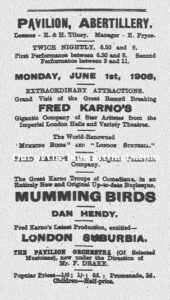 The Fred Karno Company.
The Fred Karno Company.
On Monday 1st of June 1908, the record-breaking attraction Fred Karno’s “Gigantic Company of Star Artistes from the Imperial London Halls and Variety Theatres” Fred Karno’s Vaudeville Company performed at the Pavilion Theatre, Abertillery. The shows were the “Mumming Birds” & “London Suburbia”.
On Monday 10th of August 1908, Fred Karno came back to the Pavilion Theatre for one week with their performance of the pantomimical extravaganza called “Saturday to Monday”.
Cinematograph Entertainment.
On Monday 9th of November 1908, it was announced that the Pavilion Theatre was showing Cinamatograph pictures. A Cinematograph was an early film projector.
Fred Karno.
On Monday 30th of November 1908, Fred Karno paid another visit to the Pavilion Theatre, Abertillery for a week’s duration with their performance of “His Majesty’s Guests”.
The Cinemegaphone.
On Sunday 24th of January 1909, the Cinemegaphone was used at the Pavilion Theatre, Abertillery. This was the first time the device had been used in the Western Valley’s. I cannot find any information on the Cinemegaphone though it was more than probably used to project the actors’ voices throughout the theatre, long before microphones came into being.
Leo Merode Trick Cyclist.
On Monday 22nd of February 1909, Mr Leo Merode performed Looping-the Loop on a bicycle. The act was described as “So marvellous that it is indescribable” and came to Abertillery direct from Paris.
Bostocks Baboons.
On Monday 22nd of March 1909, Bostock’s Baboons appeared at the Pavilion Theatre, Abertillery. They were advertised as “The cleverest troupe of performing baboons in the world” introduced by Capt. Grahame. They were backed by the Bouncing Patterson’s, a trampoline act from America.
One of the baboons was the celebrated animal over which a lawsuit was fought between Bostock’s and its trainer, which legal costs came to over £1,000. It was stated that one could see why after getting a glimpse of its exploits and human trickery.
Mr F. Drake.
In May 1910 Mr F. Drake the Pavilion Bandmaster left Abertillery for a summer tour. His fellow members of the Liberal Club, Abertillery gave him a purse of gold in appreciation of his social qualities at a presentation night. Mr Drake lived at Richmond Road, Abertillery and was a schoolteacher, he was member number 240 in the Liberal Club, Abertillery.
The Proposed Reconstruction of the Pavilion Theatre.
During the Great War, Mr Arthur Tilney closed the old Pavilion Theatre and totally reconstructed the building, the new Pavilion Theatre was built, it was to be constructed of reinforced concrete and built to accommodate more people.
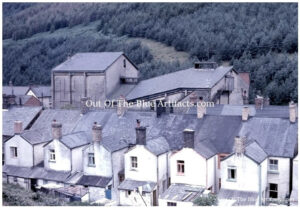 The New Pavilion Theatre.
The New Pavilion Theatre.
In October 1915 Messrs Tilney had the old Pavilion Theatre, Abertillery fully reconstructed (as seen in the images right), the walls, stairways and staircases were made from reinforced concrete, making the whole building practically fire-proof. The main hall was moved to the Glandwr Street side. On the far side the steps lead down to the left towards the shilling and six penny seats, while to the right was the entrance to the lower priced seats.
The image featured (right) was kindly supplied courtesy of Cinema Wales and Mr Phillip Walkley.
Description of the New Building.
In the center of the hall was a fine staircase leading to the balcony where the seats were 9d. The boxes were set with moulded plaster fronts of cupids and flowers decorations, the roof was also finely decorated with artistic plasterwork and was 44′ feet high, enabling the curtains and scenery to be raised and dropped without the need to be rolled. Another feature of the Pavilion Theatre was a dual heating installation, the radiators could be turned off in the auditorium while the stage and dressing rooms were still given warmth. The scenery was exceptionally fine and was designed and created by Mr J. Leas the Pavilion’s scenic artist. The Pavilion Theatre also had its own electricians, being Mr J. Cross and assistants.
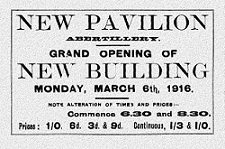 The Official Opening of the New Pavilion.
The Official Opening of the New Pavilion.
On Monday 6th of March 1916, the new Pavilion Theatre, Abertillery was opened to the public. Mr Arthur Tilney secured the exclusive rights for the new Pavilion Abertillery to show the famous Charlie Chaplin films.
On Monday 13th of March 1916, twice nightly and through the week the artists were “The Four Ormondes” a comedic cycling troupe, they included a “Charles Chaplin” impersonator; “John, Tom & Baby” a pot-pourri act; “George Crowther” a vaudeville favourite: In between acts exclusive pictures were shown.
Mr Charlie Chaplin.
There was a long-held belief that Mr Charlie Chaplin had appeared at the Pavilion Theatre, Abertillery and the rumour spread through word of mouth, the belief was not only held but strongly defended by the locals that the great “Charlie Chaplin” had indeed visited Abertillery and graced the boards at the Pavilion.
 I have researched this to the death and found no proof what-so-ever that he did appear at Abertillery. In my opinion the rumour came from the fact that there was a Charlie Chaplin lookalike impersonator performing the week after the official opening of the Pavilion Theatre in March 1916, as seen on the ad (right) and that they were exclusively showing his films, someone must have walked home “worse for wear” and said to his or her family “I just saw Charlie Chaplin in the Pavi!” and the rumour started from there.
I have researched this to the death and found no proof what-so-ever that he did appear at Abertillery. In my opinion the rumour came from the fact that there was a Charlie Chaplin lookalike impersonator performing the week after the official opening of the Pavilion Theatre in March 1916, as seen on the ad (right) and that they were exclusively showing his films, someone must have walked home “worse for wear” and said to his or her family “I just saw Charlie Chaplin in the Pavi!” and the rumour started from there.
Even though Fred Karno’s troupe came to Abertillery on a few occasions during 1908, Charlie Chaplin was not a player at this time. Later, Charlie Chaplin joined the company and did a small tour of South Wales but a venue at Ebbw Vale was the closest the troupe came and even though Charlie Chaplin was in that troupe there is no evidence he appeared on stage (further information can be found in an excellent book titled “Chaplin – Stage by Stage” by A. J. Marriott).
Later in the 1920’s Mr Fred Karno once again came to Abertillery and did shows in the Metropole in 1925, though by this time Charlie Chaplin was in the U.S.A.
Mr L. M. Harding.
During 1916 the conductor of the Pavilion Band was Mr L. M. (Lance) Harding.
In the 1920’s to watch a show at the Pavilion would cost you – Balcony 3s. Stalls 2s. 6d. Pit 1s. The manager was still Mr E. Pryce and the conductor was Mr F. Drake.
Mr Frank Harding.
In the early 1920’s Mr Frank Harding was the conductor of the Pavilion Orchestra.
Renovations of 1922.
In June 1922 the Pavilion Theatre was closed for cinema renovation. The stage and theatre was still available for theatrical performances and meetings etc.
The Cinema Conversion.
On New Year’s Day 1st of January 1923, the Pavilion Theatre re-opened after extensive renovations and the installation of Super-Cinema. It was reported that the Pavilion Theatre had the cinema conversion and would only show the best most up-to-date films available. It also employed a first-class orchestra to enhance the films that were being shown. After this date the Pavilion was advertising films five-days per week and the theatrical performances were getting few and far between. It seems that at this time the Pavilion converted to a picture house.
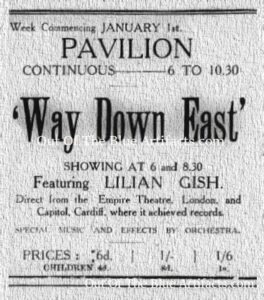 First Film Shown in Super-Cinema.
First Film Shown in Super-Cinema.
After the reopening of the Pavilion Cinema on New Year’s Day 1923 the first film that was screened was Mr D. W. Griffiths’ feature film “Way Down East” starring Miss Lilian Gish and Richard Barthelmess. The film was reported to have come direct from the Empire Theatre London and the Capitol Theatre, Cardiff where it had achieved records. The admission charges at the Pavilion Theatre were – 6d. 1s. and 1s. 6d. Children’s charges were – 4d. 8d. and 1s.
Way Down East.
The feature film “Way Down East” was produced in 1920 and had achieved an unprecedented run of 271 performances at the Empire Theatre, London during 1922. The management of the Pavilion Theatre Abertillery were congratulated on securing such a masterpiece.
Mr F. Ashcroft.
In February 1923 Mr F. Ashcroft was the conductor of the Pavilion Orchestra. Mr Ashcroft had previously been conductor at the Capitol Theatre, Cardiff.
War Memorial Services Venue.
Before the War Memorial was built at Somerset Street, Abertillery the citizens of Abertillery used to hold memorial services at various places in and around the town. In the mid 1920’s the Pavilion Picture House was one of those venues.
Engineers Wages in 1927.
In 1927 engineers’ wages at the Pavilion Picture House, Abertillery were £3. 3s. 0d. per week.
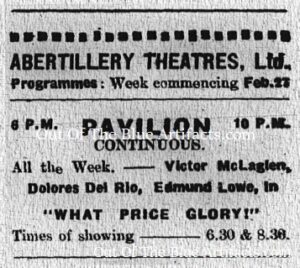 The Abertillery Theatres Limited.
The Abertillery Theatres Limited.
In the 1920’s all the Abertillery Picture Houses were owned by the Abertillery Theatres Limited. The general manager of the company was Mr Albert Jackson Withers, the manager at the Pavilion, Abertillery was Mr Alfred Withers.
Mr W. Lewis.
In 1928 Mr W. Lewis was the conductor of the Pavilion Orchestra.
The Electric Sub-Station.
In February 1929 the council wanted to erect a small electrical sub-station in the grounds of the Abertillery Tinplate Company although the company wanted £10 per year, this was deemed too much and Mr Jackson Withers the manager of the Abertillery Theatres was approached. Mr Jackson gave permission to the council for the sub-station to be built upon his grounds at the Pavilion for a rental of just £1. per annum and with conditions that the council allow the company the use of billboards on Alma Street and for a small rental and also to have use of the electricity for his cinema.
The Introduction of the First Talking Movies.
The early film shows in the theatres were stills projected onto a fixed screen such as Magic Lanterns or Bioscope images. Later Cinematographs came into being and then moving pictures were shown in the theatres. All these various film techniques were silent movies with the resident theatre orchestras providing the music to augment the viewing experience. It is noted that the first proper talking “Talkie Movie” was the Jazz Singer, starring Al Jolson, this movie was released in 1928 and it had the music and voices synchronised with the film.
The First Talkie Movie Shown at Abertillery.
The first Talkie Movie the “Jazz Singer” released in October 1927 was first shown at the Palace Picture House, Abertillery in March 1929. The Jackson Withers Company chose the Palace Picture House for this film’s debut over the rest of the theatres in the area. Later in February 1930 the follow-up to “The Jazz Singer”, “The Singing Fool” starring Al Jolson, Josephine Dunn and Betty Bronson was shown at the Empress Picture Hall, Abertillery.
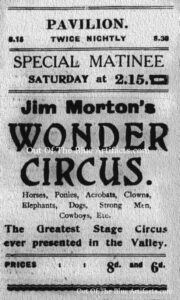 Jim Morton’s Wonder Circus.
Jim Morton’s Wonder Circus.
On Saturday 26th of April 1930, (as seen in the advertisement left) Jim Morton’s Wonder Circus came the Abertillery and appeared at the Pavilion. The performance featured Horses, Ponies, Clowns, Acrobats, Elephants and Strong-Men etc and was described as being the greatest stage circus ever presented in the valley.
Skating on Ice at the Pavilion Theatre.
On Friday 21st of April 1950, the South Wales Gazette advertised – “New to Abertillery” at the Pavilion Theatre next week “Ice Carnival”, famous skating stars, a full chorus and ballet – Skating on real ice. Twice nightly – 6.00pm and 8.15pm with a matinee on Saturday.
The Abertillery Amateur Operatic and Dramatic Society.
In 1951 the Abertillery Amateur Operatic and Dramatic Society made the Pavilion Theatre, Abertillery their home for future performances. Their society had been performing at the Metropole Theatre since 1917 though had disbanded in 1939.
VistaVision at the Pavilion Theatre.
In February 1955 VistaVision came to the Pavilion Theatre, Abertillery. The first film shown in VistaVision was “White Christmas” starring Bing Crosby and Rosemary Clooney.
CinemaScope at the Pavilion Theatre.
In March 1959 the Pavilion Theatre, Abertillery was equipped to show CinemaScope. The old 19′ x 14′ foot screen was replaced by a larger 23′ x 13′ foot screen capable of screening the new format feature films. The Pavilion had been showing CinemaScope productions since 1955 although they were screened on the old 19′ x 14′ foot screen by means of reducing lenses, this enabled the projectionist to squeeze the image onto a smaller screen, this was the cheaper way of showing scope films.
Mr Sir Julian Hodge.
The Jackson Withers Company which stretched across South Wales later made Sir Julian Hodge a partner in the company. Mr Jackson Withers was Managing Director with Sir Julian Hodge being Chief Executive. In the late 1960’s the cinema was becoming less attractive to the audiences and during the 1970’s the Rank Organisation approached Julian Hodge and offered to buy the Jackson Withers Cinemas to convert, add to and expand their Top Rank Bingo Clubs. By 1976 all the cinemas in the circuit had been purchased. The Pavilion, Gaiety and the Empress and long been closed with only the Palace Picture House being kept open and converted.
Mr David Pembridge.
In April 1960 sixteen-year-old David Pembridge of Alma Street, Abertillery was commissioned by the Abertillery Theatres Ltd to paint in oils Mr Cliff Richard, Cliff starred in the film “Expresso Bongo” and the lady with the winning ticket on the night of the film showing at the Pavilion was to receive the portrait as the prize. The general manager at this time was Mr D. K. Evans.
Mr Richard Attenborough.
In August 1960 Richard Attenborough was at the Pavilion in support of the Six Bells miners. There was information and pictures in the South Wales Gazette on both the 12th and 19th of August that year.
Bingo at the Pavilion.
In December 1961 the Pavilion Bingo Club announced that owing to such popularity in the game the club was to be open for bingo seven nights a week. Over 1,300 people were present over two sessions on the previous Sunday with the prize money being £400. Mr Dillwyn Lewis was the general manager of the Abertillery Theatres Ltd.
The Abertillery Amateur Operatic and Dramatic Society.
In 1962 the Abertillery Amateur Operatic and Dramatic Society who had been using the Pavilion Theatre as their home relocated back to the Metropole Theatre, Abertillery. During their stay at the Pavilion the society produced and performed eleven shows at the theatre.
The Closure of the Pavilion as a Cinema.
On Friday 23rd of November 1962, the South Wales Gazette reported on the closure of the Pavilion as a cinema, it stated the building was to stay open as a bingo venue on weekends and it was also being considered to open for bingo on weekdays.
The Pavilion reopening for Film Performances.
On Monday 11th of February 1963, the Pavilion once again opened for films, the bingo was confined to every Sunday nights. The first film shown after its reopening was Kid Galahad starring Elvis Presley.
Closure of the Pavilion.
I am still searching for a confirmed date of closure of the building.
The Later Years.
The Pavilion was demolished in the mid to late 1970’s. Its site was later occupied by the new Lymes Social Club, now called the Foundry.
More Reading and Information.
The following is a Link to – Welsh Cinemas.
Points of Interest – Mr Arthur Tilney.
Mr Arthur Tilney was born in Kirby Bedon, Norwich Norfolk in November 1843. The son of Mr Robert Tilney of Norwich a young Arthur attended the local school and was educated by the Rev Dr Purnell. At the age of 17 years he left Norwich on medical advice and he came to settle in Abertillery, thinking the mountain air would help his frail health, this town was ideal for him.
In 1871 Mr Arthur Tilney born 1844 at Kirby Bedon, Norwich Norfolk was Station Master at Abertillery, he was living with his wife Annie Tilney nee James, daughter of Mr William James of Trevethin born 1845 and family daughters Misses Margaret Tilney born 1866, Emily Laura Tilney born 1867, Edith Getrude Tilney born 1868, Agnes Beatrice Tilney born 1871. Mr Tilney was living at Llanhilleth.
Upon arrival at Abertillery he worked as a clerk for the Monmouthshire Railway Company, later he was the station master though resigned when the Great Western Railway Co took over the old railway company.
In 1865 Mr Tilney married Miss Annie James, daughter of Mr William James of Trevethin later Abertillery.
In the late 1870’s he was employed by Captain Phillips the owner of the Abertillery Tin Plate Works as an accountant at the Tin Works, Abertillery.
Mr Tilney had an ironmongery shop in Market Street, Abertillery, was listed as a timber merchant and was the local shipping agent. At this time Mr Tilney lived with his wife Annie and children Misses Annie Margaret Tilney, Emily Laura Tilney, Edith Gertrude Tilney, Agnes Beatrice Tilney, Rosa Kate Tilney born 1873, Mabel Winnifred Tilney born 1876, Cicely Ida Tilney born 1880 and Master Ernest De-Caux Tilney born 1878.
He made arrangements to purchase the Abertillery Timber Mill from Mr Alexander James Esq, Mr James was the son of Mr Edmund James of Clyn Mawr Ganol, a family of landowners at Blaenau Gwent. Clyn Mawr Ganol (middle farm), The Clyn Mawr Ganol is now Penybont Nursing Home, a private Nursing Home on Portland Street, Blaenau Gwent.
In 1879 Mr Tilney set up his newly acquired timber business opposite the Abertillery Tin Works on Station Approach close to the Railway Inn, this works grew into one of, if not the biggest timber businesses in South Wales. Mr Tilney named his business the Western Valley’s Steam Saw Mills. He not only made his money from timber he also dealt with and traded in other goods. He didn’t seem content with just running his own business and branched out in other projects and schemes. In conjunction with Rev O. S. Richards he set up the Western Valley Weekly News – the forerunner to the South Wales Gazette.
In 1881 Mr Tilney was living at No.1 Waen Wern, Abertillery with his wife Annie and family daughters Emily Laura Tilney (Draper), Edith Gertrude Tilney (Draper), Agnes Beatrice Tilney (Clerk), Rosa Kate Tilney (Music Teacher) and Cicely Ada Tilney, with sons Ernest De-Caux Tilney (Clerk), Harold De Caux Tilney born 1888 and an adopted son James H. James born 1884.
In 1892 he purchased the old Wallace’s Brickworks in Cwmtillery (Woodland Brick Works) he advertised for tenders to builders for the construction of new kilns and started to produce his own red bricks, examples of these can be seen in the Abertillery Museum.
In 1899 he became a director of the Abertillery Tin Works and later in 1900 set up his own company to take the tin works over, at this time they were renamed the Glan Ebbw Steel Sheet Galvanising and Tin Plate Company Ltd.
Mr Arthur Tilney was a wheelwright and built carts and caravans etc. He had his own land in the Carlyle Street area close to his works and he was a great supporter of the arts and entertainment industry and worked with and organised the various travelling theatres to his grounds. He also became a councillor and was the leading force behind constructing the outdoor swimming baths and in getting a recreation grounds at Abertillery.
In 1901 the family were living at Carlyle House, Carlyle Street, Abertillery.
In 1907 Mr Tilney decided to build his own entertainment hall and upon his land he arranged for the construction of the Pavilion Theatre which he made into a grand theatre with the second largest stage in South Wales next to Cardiff’s New Theatre and with his contacts in the show business world he had a vast amount of talent to exhibit.
In 1909 he set out on a new project, the building of the Empress Skating Rink, this building was quite large and built on his land on the corner of Station Approach and Carlyle Street. When the pastime of roller skating dwindled, he turned the hall into a Picture Palace.
In 1910 he began to suffer with ill health and retired from work. He was living in Carlyle House, Carlyle Street. On the 1911 census he was living in Carlyle House with his wife Annie, his eldest son Ernest De Caux Tilney, the theatre manager and employer and Harold De Caux Tilney the manager of the Public Hall, Abertillery.
In 1915 Mr Tilney had the old Pavilion Theatre fully reconstructed.
In November 1917 Mr Tilney sadly died at his home in Gold Tops, Newport aged 74 years. He was buried at Newport and his funeral was a private affair. He was spoke of being a leading figure in the history of Abertillery, a pioneer and visionary.
Mr Ernest de Caux Tilney.
Mr Ernest de Caux Tilney was educated at the British School, Abertillery, his wife was Emily Harriet de Caux Tilney, they later lived at “Druidstone”, St Mellons, Cardiff. Mr Ernest de Caux Tilney died on 9th of May 1939 and he left an estate valued at £59,891. equivalent to nearly £4,000,000 in today’s money.
The information on Mr Richard Attenborough at the Pavilion in 1960 and Mr Ernest de Caux Tilney was kindly supplied courtesy of Mr Bryan Boots.
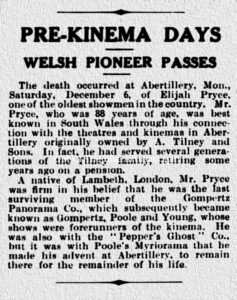 Mr Elijah Pryce.
Mr Elijah Pryce.
Mr Elijah Pryce, a pioneer of Welsh kinema was the manager of the Pavilion Theatre, Abertillery. Born in 1847 at Lambeth, London, Mr Pryce also became a showman, though very little is known of him or documented apart from the fact he was a musician and also manager of the Gompertz Panorama Company and the Gompertz, Poole and Young & Co. Mr Elijah Pryce married Miss Catherine Gompertz in 1874, daughter of the company proprietor Mr M. Gompertz, although was divorced in 1879 and married again in 1882 to a Clara, surname unknown?
It was reported that he came to Abertillery in the early 1900’s as manager of “Peppers Ghost” of the Gompertz Spectroscope Company, he became associated with the Tilney family at that time, he decided to stay at Abertillery and became a theatre manager at the Pavilion Theatre. He lived at 7 Carlyle Street, Abertillery. In February 1935, his wife Clara passed away.
The Death of Mr Pryce.
In December 1935, Mr Pryce passed away, at the time of his death he lived at 100 Oak Street, Abertillery. The news clipping (above) is from the “Kinomatograph Weekly” dated December 12th, 1935.
 Out Of The Blue Artifacts A Library of a lifetime of collecting
Out Of The Blue Artifacts A Library of a lifetime of collecting
